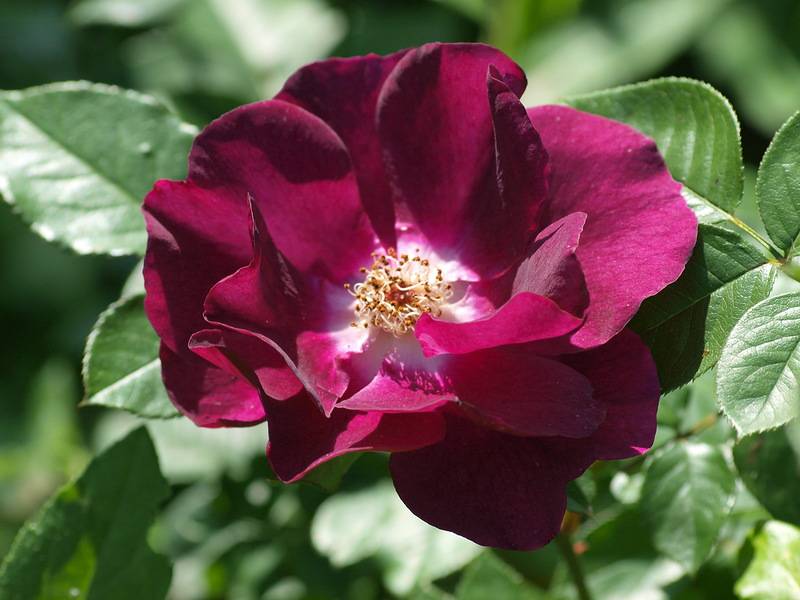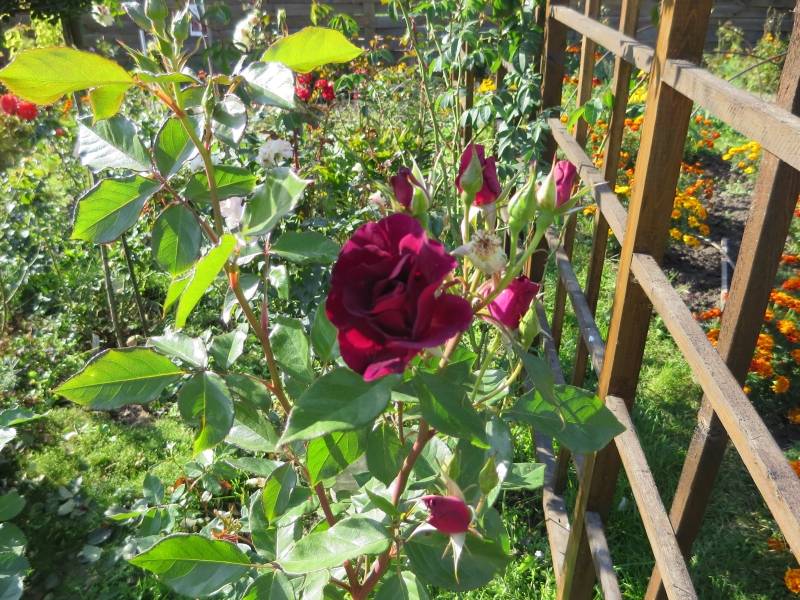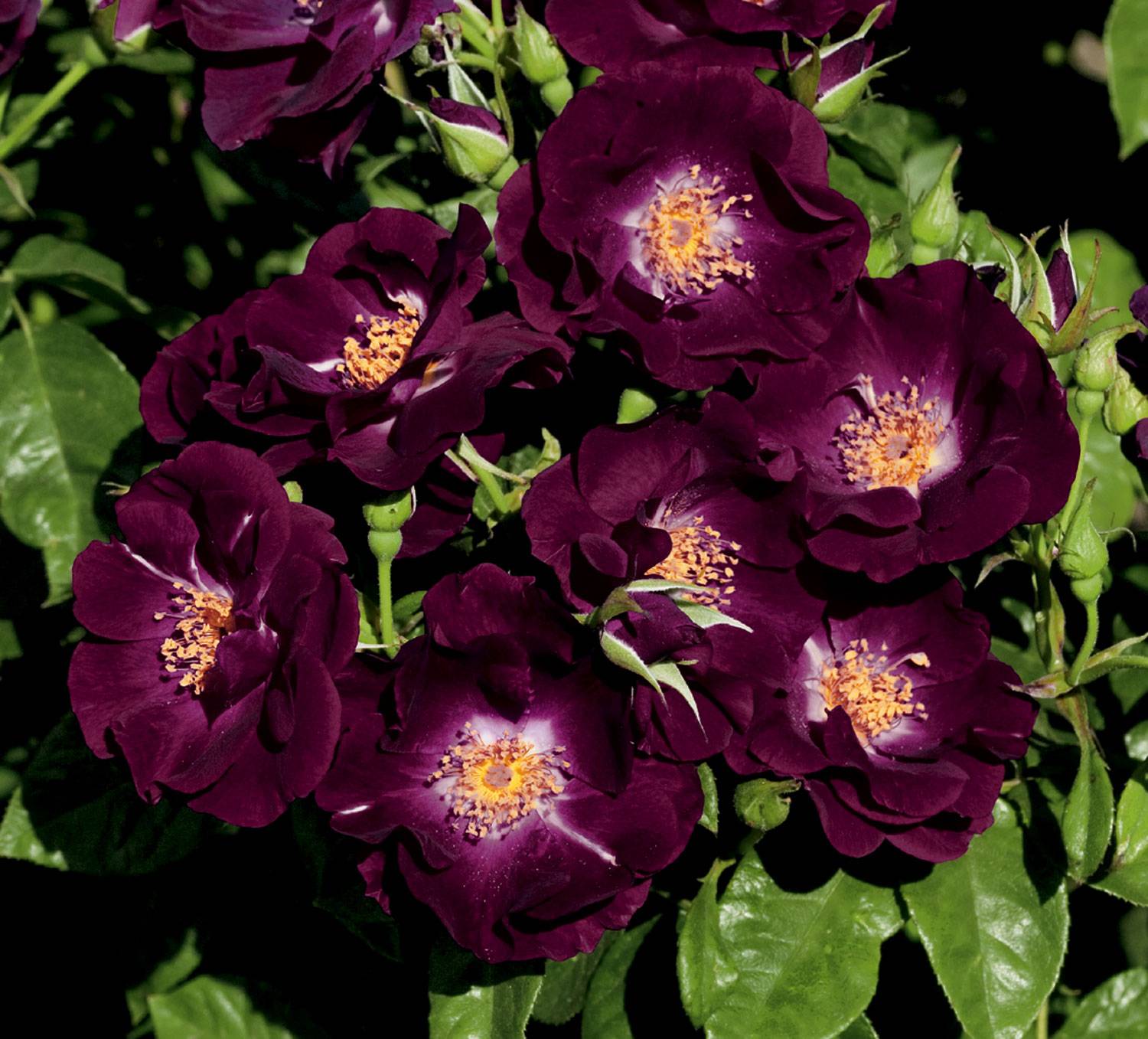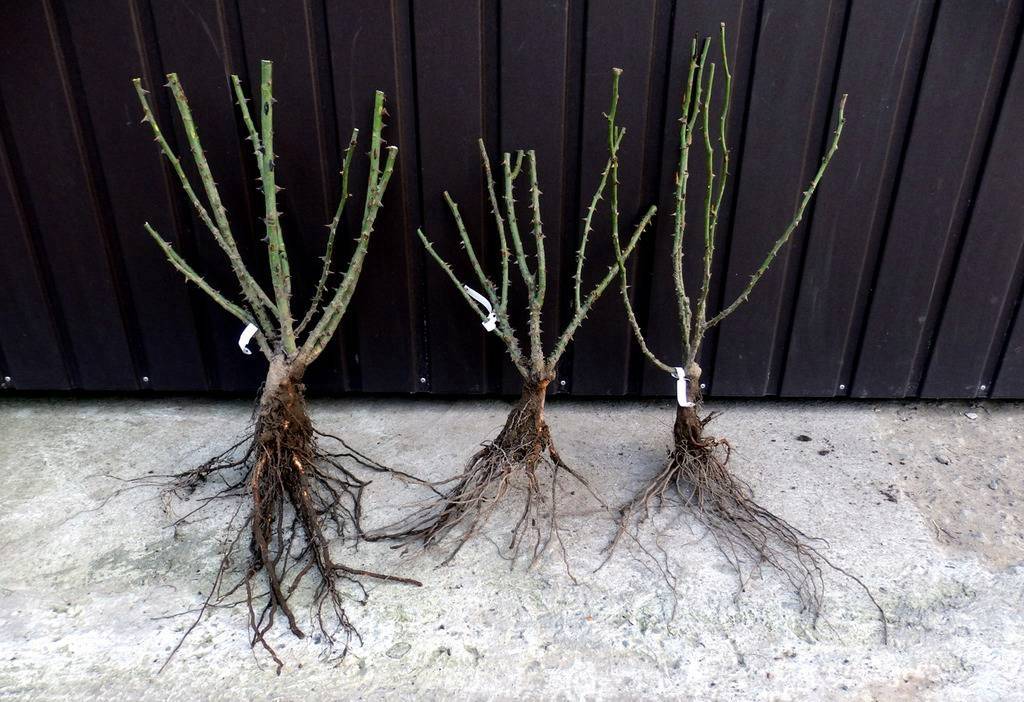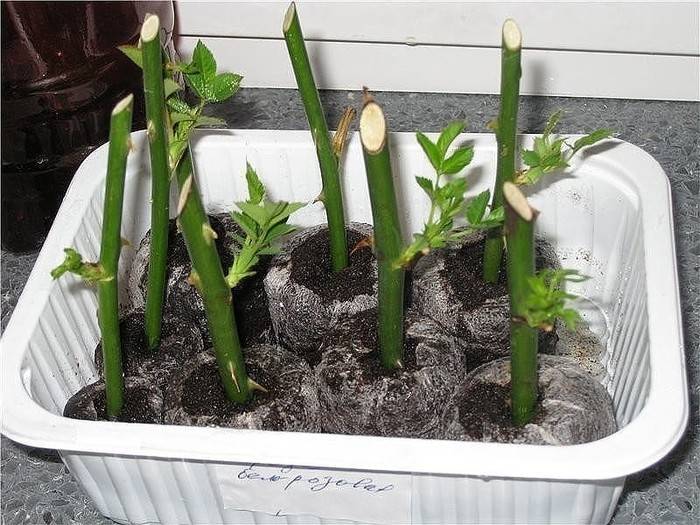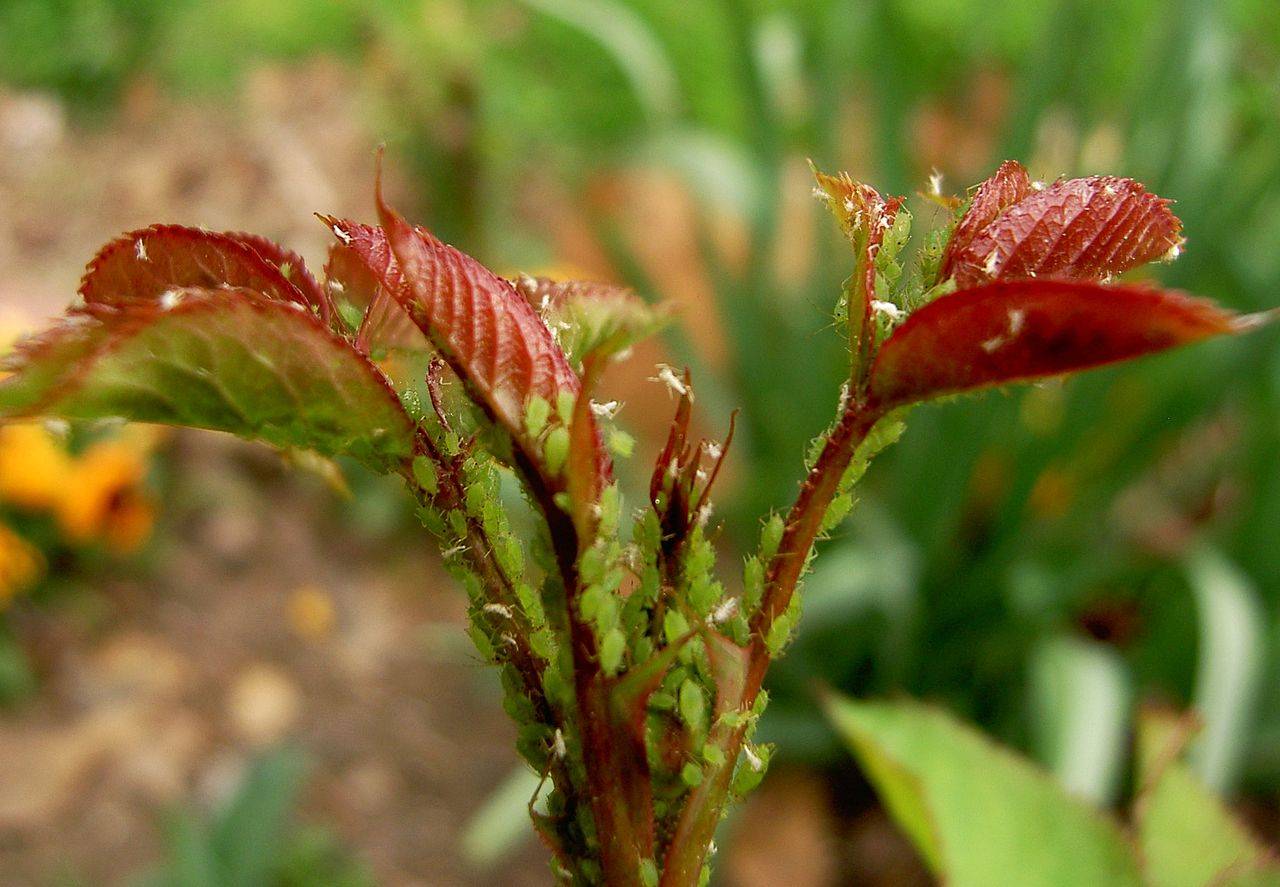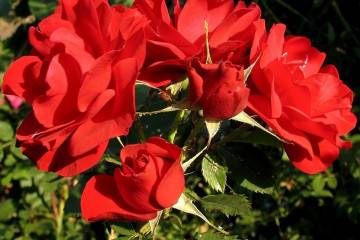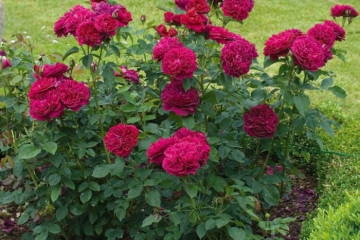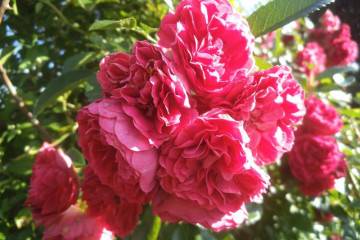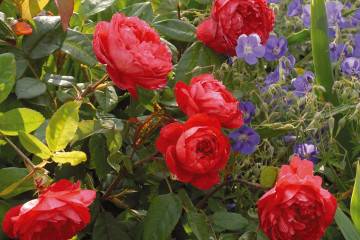Rose Night Owl (Night Owl) - description of climbing climbing
Content:
The most beautiful burgundy climbing rose foribunda Night Owl belongs to the Climber group, that is, re-blooming. Depending on the conditions of detention, lighting and other factors, the shade of its petals can play from purple-burgundy to rich blood-scarlet.
Rose Night Owl - what is this variety, history of creation
The cultivar Nochnaya Owl is credited to breeder Tom Carruth, who presented the result on behalf of Weeks Wholesale Rose Grower in 2007.
Brief description, characteristic
The bush is formed from long, spreading whips, reaching a length of 3-4.2 m. The variety has almost no thorns, which attracts gardeners and makes it easier to work with the crown of the bush. The foliage is semi-gloss, painted in a gray-green tint.
Corollas consist of 8-12 burgundy petals with wavy edges, the total diameter is up to 10 cm. The center is filled with bright yellow stamens. The shade of the flower remains saturated until it wilts completely. Shoots end in clusters of 3-5 buds and look very impressive in full dissolution.
The aroma is of medium intensity, sweet, with clove notes. From the first year of planting, the rose blooms in two waves with a short break.
Advantages and disadvantages of the variety
An important advantage of the Night Out rose (another trade name is Vicks) is that it can be grown outdoors throughout the temperate zone, that is, in most of the Russian regions, including the Moscow region.
Disease resistance is average, which means the need to follow mandatory preventive measures. Some flowers may be damaged when it rains.
Use in landscape design
The optimal use of the variety is to decorate various supports: pergolas, trellises, fences, gazebos, etc. Without support, the whips are prone to drooping, which spoils the appearance of the plant.
Growing a flower, how to plant it in open ground
Agrotechnics are exactly the same as for most climbing varieties. Rose Night Owl can stay in one place for several decades.
In what form is the landing
In nurseries, seedlings are sold with open and closed roots. In the first case, planting in open ground should be performed as soon as possible. A high-quality bush has from 2 lignified shoots up to 70 cm long. It is easy to check the vitality - bend the shoot slightly, after which a characteristic light crunch should be heard.
Seedlings with a closed root system can only be judged by the appearance of the shoots, which should not be too light and elongated. At the grafting site, the callus tissue should be convex and not flake off, only in this case the seedling will start growing immediately after planting.
What time is the boarding
Can be planted in spring and autumn.The best time is the end of April, when the buds have not yet blossomed, but the soil has already warmed up above + 10 ° C, or 3 weeks before the start of frost in the area.
Location selection
The place at any support should be sunny and well ventilated. Swampy soil, sandstone, heavy alumina are categorically unsuitable. The best substrate is loose loam and black soil. The root system goes down to 2 m, so the groundwater horizon should lie lower.
How to prepare the soil and flower for planting
It is advisable to add a little sand to the clay soil, and clay, as well as humus or humus, phosphorus fertilizer to the sandy soil.
Before planting, the roots are shaken off the soil and shortened, leaving only 30 cm.The branches are also cut off, leaving only 20 cm.
Planting procedure step by step
The procedure is as follows:
- Pits are dug 60-70 cm deep at the same distance from each other.
- The root collar is buried 12 cm to protect the bush from winter frosts.
- The roots are straightened and sprinkled with soil, into which it is worth mixing up to 5 kg of peat compost.
At the end, the soil is watered and mulched with sawdust or peat.
Plant care
Rose Night Owl needs constant care. Only then will its crown be lush and abundant flowering.
Watering rules and humidity
In the hot season, watering is carried out every 5 days, but with regular rains, you can do without it. Spraying can only be done in dry conditions, with warm water after sunset, and only on foliage. Water consumption for irrigation is 10-12 liters for each plant.
Top dressing and soil quality
Throughout the summer, with an interval of 2-3 weeks, complex mineral and organic fertilizers should be applied alternately. Agricola-Rosa and the organic dressing Ideal have shown themselves well.
Pruning and replanting
In winter, only 10-12 of the strongest shoots are left, the rest are cut out. In the summer, wilted buds and branches growing inside the crown are cut.
Features of wintering a flower
After the foliage has fallen off, all the lashes should be removed from the support, bent to the ground and covered. As a covering material, you can use agrotextile, dry foliage and spruce branches. Additionally, the bushes are spud up to a height of 30 cm. They remove the shelter after the establishment of warm weather.
Blooming rose
Lush flowers are the result of the gardener's hard work. Climbing roses are subject to standard rules.
A period of activity and rest
The first bud dissolution occurs in late May - early June. It usually lasts up to 4 weeks, after which there is a break for 6-8 weeks. Next, the second wave begins, which ends with the arrival of frost.
Care during and after flowering
During flowering, the bushes need regular watering and the removal of wilted flowers. If pests are identified, then insecticide treatment should be carried out. After the completion of the second wave of flowering, autumn pruning is carried out.
What to do if it does not bloom, possible reasons
Possible sources of problems include the following:
- Diseases. With the dissolution of foliage in the spring, it is necessary to carry out mandatory two-time treatments with Bordeaux liquid or another copper-containing fungicide.
- Wild growth. Since seedlings are often grafted onto a rose hip, shoots may appear from the roots, which must be cut out.
- Excess nitrogen. This is dangerous not only by the appearance of diseases, but also by the predominance of the growth of shoots and foliage to the detriment of flowering.
- It's too dark. It is necessary to transplant the bush to a sunny area.
Flower propagation
The optimal method that gives an almost 100% guarantee of success is cuttings. A shoot with two internodes is cut off, the lower leaves are removed from it and the upper leaves are shortened by half. For a guarantee, take several cuttings (with a margin).
When is it produced
The best time to cut cuttings is mid-July, when the first wave of flowering has ended. If there are buds at the end of the shoot, they are removed.
Detailed description
The stalk is immersed in nutrient soil for 2-3 cm, covered with a glass jar and placed in a slightly shaded place. Water as the soil dries. The shelter is not removed until all the buds begin to grow.
For the winter, the cuttings are sent to a warm (+ 15-20 ° C) well-lit place, planting in open ground only with the arrival of next summer.
Diseases, pests and ways to control them
The greatest threat to climbing roses is bacterial cancer (there is no cure for it) and fungal diseases.
With the arrival of heat, but before the buds dissolve, spraying with Bordeaux liquid is carried out, and after 2 weeks - repeated. The revealed diseased shoots are cut out with the capture of healthy tissues and burned. Preparations help from pests: "Aktara", "Karbofos", "Inta-Vir".
Raising a Night Owl is not that difficult. With regular watering, dressing and pruning, it will curl at any support and bloom more and more magnificently every year.
